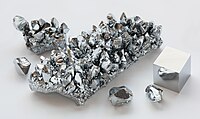
Photo from wikipedia
Electrochemical oxidation of trivalent chromium from leather tanning mud waste leachates (containing ca 6 g.L−1 Cr(III)) to its hexavalent form was carried out using a PbOx/Pb anode electrode in a… Click to show full abstract
Electrochemical oxidation of trivalent chromium from leather tanning mud waste leachates (containing ca 6 g.L−1 Cr(III)) to its hexavalent form was carried out using a PbOx/Pb anode electrode in a prototype small (0.4 L) cylindrical batch electrochemical reactor. The PbOx/Pb anode was prepared by electrochemical anodization at constant current (75 mA cm−2 for 30 min) in a sulfuric acid solution and characterized by the cyclic voltammetry technique to investigate the effect of pH on the process. It was found that at pH = 3, Cr(III) oxidation prevails over the competing water oxidation-oxygen evolution reaction (OER), hence increasing the efficiency of the process. A detailed study of pH (0–3), current density (12–24 mA cm−2), and cell type (divided-undivided) effects on bulk electrolysis of Cr(III) leachates in the batch prototype reactor resulted in process optimization. At pH = 3, 12 mA cm−2 and a cathode inserted in a porous diaphragm envelope, nearly 70% conversion was achieved at a nearly 60% current efficiency, among the highest in the previously reported literature. The method (further optimized with an ion-selective membrane separator) could offer an attractive route for tannery Cr(III) conversion to Cr(VI) for reuse as an etchant or electroplating agent.
Journal Title: Environmental Science and Pollution Research
Year Published: 2022
Link to full text (if available)
Share on Social Media: Sign Up to like & get
recommendations!